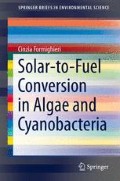Abstract
Light-driven reactions of photosynthesis have to fit downstream biochemical reactions that become limiting at increasing light intensities. As a consequence, photosynthesis displays a light saturation curve. Dissipation of excess absorbed energy by non-photochemical energy quenching, although it is responsible for diminishing light utilization efficiency, is essential for protecting the photosynthetic apparatus from photo-oxidative stress.
Access this chapter
Tax calculation will be finalised at checkout
Purchases are for personal use only
References
Asada K (1999) The water-water cycle in chloroplasts: scavenging of active oxygens and dissipation of excess photons. Annu Rev Plant Physiol Plant Mol Biol 50:601–639
Chisti Y (2007) Biodiesel from microalgae. Biotechnol Adv 25:294–306
Formighieri C, Franck F, Bassi R (2012) Regulation of the pigment optical density of an algal cell: filling the gap between photosynthetic productivity in the laboratory and in mass culture. J Biotechnol 162(1):115–123
Krieger-Liszkay A (2005) Singlet oxygen production in photosynthesis. J Exp Bot 56:337–346
Ledford HK, Chin BL, Niyogi KK (2007) Acclimation to singlet oxygen stress in Chlamydomonas reinhardtii. Eukaryot Cell 6:919–930
Melis A (1999) Photosystem-II damage and repair cycle in chloroplasts: what modulates the rate of photodamage in vivo? Trends Plant Sci 4:130–135
Melis A (2009) Solar energy conversion efficiencies in photosynthesis: minimizing the chlorophyll antennae to maximize efficiency. Plant Sci 177:272–280
Melis A, Neidhardt J, Benemann JR (1998) Dunaliella salina (Chlorophyta) with small chlorophyll antenna sizes exhibit higher photosynthetic productivities and photon use efficiencies than normally pigmented cells. J Appl Phycol 10:515–525
Peers G, Truong TB, Ostendorf E, Busch A, Elrad D, Grossman AR, Hippler M, Niyogi KK (2009) An ancient light-harvesting protein is critical for the regulation of algal photosynthesis. Nature 462:518–521
Wagner D, Przybyla D, Op den Camp R, Kim C, Landgraf F, Lee KP, Wursch M, Laloi C, Nater M, Hideg E, Apel K (2004) The genetic basis of singlet oxygen-induced stress responses of Arabidopsis thaliana. Science 306:1183–1185
Zhu SH, Green BR (2010) Photoprotection in the diatom Thalassiosira pseudonana: role of LI818-like proteins in response to high light stress. Biochim Biophys Acta 1797:1449–1457
Author information
Authors and Affiliations
Rights and permissions
Copyright information
© 2015 Springer International Publishing Switzerland
About this chapter
Cite this chapter
Formighieri, C. (2015). Light Saturation of Photosynthesis. In: Solar-to-fuel conversion in algae and cyanobacteria. SpringerBriefs in Environmental Science. Springer, Cham. https://doi.org/10.1007/978-3-319-16730-5_11
Download citation
DOI: https://doi.org/10.1007/978-3-319-16730-5_11
Publisher Name: Springer, Cham
Print ISBN: 978-3-319-16729-9
Online ISBN: 978-3-319-16730-5
eBook Packages: Earth and Environmental ScienceEarth and Environmental Science (R0)

